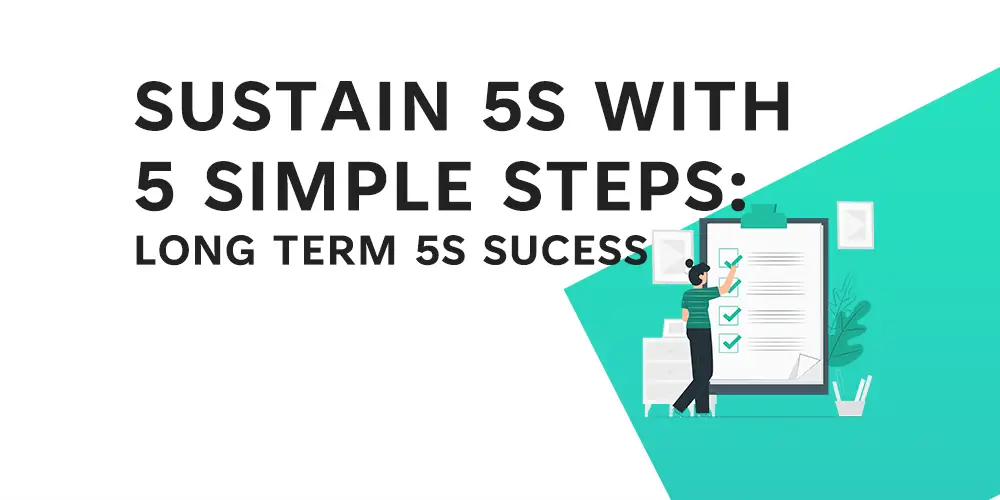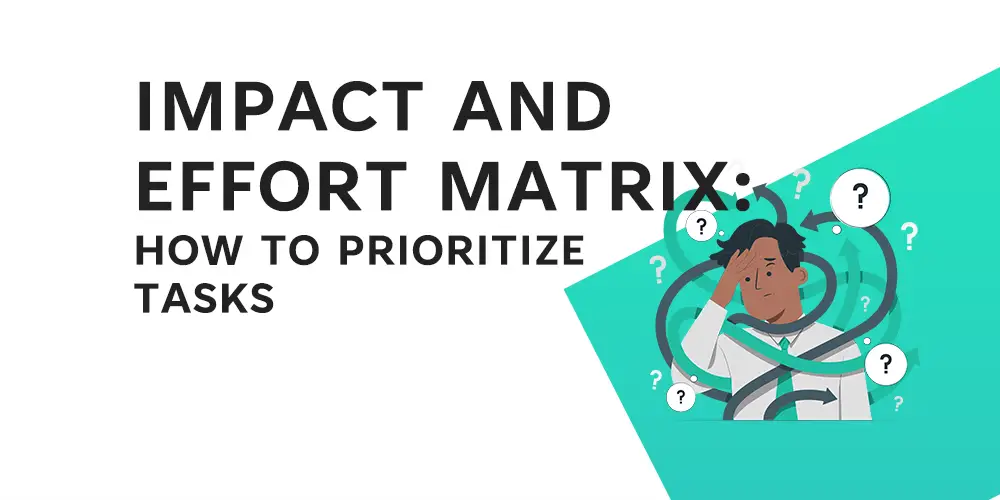In today’s fast-paced and ever-changing business landscape, it is more important than ever to keep your workplace clean, organized, and efficient. This is where the 5S concept comes into play. 5S is a workplace organization system that emphasizes sorting, simplifying, sweeping, standardizing, and maintaining a clean and organized workspace. This system not only improves overall workplace efficiency, but it also creates a safer and more productive environment for employees.
However, simply implementing 5S is insufficient. To reap the full benefits of this system, it must be maintained over time. Many organisations struggle with this, as keeping a clean and organised workspace can be a constant challenge.
In this blog post, we will look at 5 easy steps to help you maintain your 5S workplace organisation for long-term success. You can keep your workplace clean, efficient, and productive by following these steps now and in the future. Continue reading if you’re ready to take your workplace organisation to the next level!
Step 1: Establish Clear Goals and Objectives
Define the Purpose of 5S in Your Workplace
The goal of 5S in your workplace serves as the foundation for your 5S implementation and maintenance efforts. It can be difficult to know where to begin, what to focus on, and how to measure success if you don’t know why you’re implementing 5S.
To define the purpose of 5S in your workplace, first examine the challenges and opportunities that your organisation faces. What aspects of organisation, cleanliness, and efficiency can be improved? What are your organization’s goals, and how can 5S help you achieve them?
Once you have a good understanding of your organization’s challenges and opportunities, it’s time to identify the specific benefits and objectives of 5S. Increased efficiency, reduced waste and downtime, improved safety, increased customer satisfaction, and a more visually appealing workspace are all common benefits.
Identify Key Performance Indicators (KPIs) for Sucess
Once you’ve defined the purpose of 5S in your workplace, it’s time to identify the key performance indicators (KPIs) that will help you measure success. KPIs are quantifiable measures of progress and success in the workplace, and they should be directly related to the benefits and objectives of 5S.
For example, if you want to cut down on wasted time, your KPI could be the amount of time saved by implementing 5S. If you want to improve safety, your key performance indicator (KPI) could be the number of accidents or incidents reduced through 5S. Improvements in productivity, quality, and customer satisfaction are also common 5S KPIs.
Set Clear and Measurable Goals for 5S Implementation and Sustainment
With a clear understanding of the purpose of 5S and the success KPIs, it’s time to set measurable goals for 5S implementation and maintenance. These objectives should be SMART, which means they should be specific, measurable, attainable, relevant, and time-bound.
A specific and measurable goal for 5S implementation, for example, could be to reduce wasted time by 10% in the first quarter of the year. A relevant and time-bound goal could be to achieve a certain level of customer satisfaction six months after implementing 5S.
Setting specific and measurable goals for 5S implementation and maintenance assists you in focusing your efforts, tracking your progress, and making data-driven decisions as you work to maintain your 5S workplace organisation. Setting these objectives will put you well on your way to long-term success with 5S.
Step 2: Involve Employees in the Process
Employee involvement and buy-in are critical to the success of 5S implementation and maintenance. It is critical to involve employees in the process from the beginning to ensure that 5S becomes a sustainable part of your workplace culture.
Encourage Employee Participation and Ownership
One of the primary advantages of encouraging employee participation and ownership is that it helps to build employee buy-in and commitment. Employees are more likely to be invested in the outcome and collaborate to ensure long-term success when they believe they have a stake in the process.
Employee participation and ownership in the 5S process can be encouraged in a variety of ways, including:
- Involve employees in planning and decision-making: This could include forming a cross-functional team comprised of employees from various departments, soliciting input and feedback on 5S initiatives, and involving employees in the development of 5S standards and procedures.
- Recognize and reward employees’ contributions: This could include recognising employees who contribute significantly to 5S initiatives, rewarding employees who consistently adhere to 5S principles, and recognising and rewarding teams who successfully implement 5S in their work areas.
- Allow employees to take ownership of specific 5S initiatives by assigning employees to lead specific 5S projects, encouraging employees to develop their own 5S initiatives, and allowing employees to take responsibility for maintaining 5S standards in their work areas.
Providing Training and Education on 5S Principles and Best Practices
Another important aspect of involving employees in the 5S process is to provide them with training and education on 5S principles and best practices. This assists in ensuring that employees understand what 5S is, what it entails, and how it can benefit the workplace.
The training should cover the benefits of 5S, the specific processes involved, and how employees can help 5S succeed in the workplace. Furthermore, the training should cover best practices for 5S implementation and sustainability, such as how to conduct 5S audits, implement 5S improvements, and measure the success of 5S initiatives.
Encourage Open Communication and Feedback from Employees

Employee open communication and feedback are critical components of involving employees in the 5S process. This includes soliciting input and feedback from employees on the implementation and sustainability processes on a regular basis and making changes and adjustments as needed based on that feedback.
Encouraging open communication and feedback can help to build transparency and trust between employees and management, leading to a more successful 5S implementation and sustainment process overall.
It’s critical to remember that open communication and feedback should be two-way. Employees should feel comfortable sharing their ideas, concerns, and feedback, and management should respond to that feedback and make appropriate changes.
Finally, involving employees in the 5S process is a critical step towards long-term success. You can help to build a strong foundation for 5S implementation and sustainability in your workplace by encouraging employee participation and ownership, providing training and education, and encouraging open communication and feedback.
Step 3: Incorporate 5S into Daily Operations
Make 5S a Part of Daily Routines and Habits
In order to become a long-term part of the workplace culture, 5S must be integrated into daily routines and habits. This means that employees should incorporate 5S principles into their daily work routines and consistently apply 5S best practices in their work areas.
Employees, for example, can be encouraged to sort and organise their work areas at the start and end of each day, to implement standard work procedures that incorporate 5S principles, and to conduct 5S audits on a regular basis to identify and correct any issues.
Making 5S a part of daily routines and habits can assist in ensuring that 5S becomes a deeply ingrained part of workplace culture and that employees consistently follow 5S principles and best practices.
Incorporate 5S into Workplace Policies and Procedures
Another important aspect of incorporating 5S into daily operations is incorporating 5S into workplace policies and procedures. This includes updating workplace policies and procedures to reflect 5S principles and best practices, as well as training employees on these policies and procedures.
Workplace policies and procedures, for example, should address how to sort and organise work areas, label and store equipment and materials, and dispose of unnecessary items. These policies and procedures should also be reviewed and updated on a regular basis to reflect the changing needs of the workplace.
Incorporating 5S into workplace policies and procedures can help to ensure that all employees adhere to consistent, standardised processes and that everyone collaborates to maintain a 5S workplace.
Regularly Assess and Improve 5S Processes
Finally, to ensure long-term success, 5S processes must be evaluated and improved on a regular basis. This includes conducting regular 5S audits to identify areas for improvement, making necessary adjustments to 5S processes, and tracking the success of 5S initiatives over time.
To measure the success of your 5S initiatives, you can use metrics such as the number of 5S audits performed, the number of 5S improvements made, and the number of employee suggestions for 5S improvements.
By assessing and improving 5S processes on a regular basis, you can identify areas for improvement and make necessary adjustments to help ensure the long-term success of your 5S initiatives.
Finally, incorporating 5S into daily operations is a critical step towards long-term success. You can help to ensure the long-term success of your 5S initiatives and create a workplace culture that is organized, efficient, and effective by incorporating 5S into daily routines and habits, incorporating 5S into workplace policies and procedures, and regularly assessing and improving 5S processes.
Step 4: Recognize and Reward Sucess
Acknowledging Employee Efforts and Achievements
Celebrating and recognising employee efforts and accomplishments is an important part of recognising and rewarding success in 5S implementation. This includes recognising and praising employees for their contributions to the success of 5S initiatives, as well as ensuring that their hard work and dedication are recognised and appreciated.
You can, for example, create a bulletin board or wall of fame to recognise and showcase employee achievements, send out regular emails or newsletters to highlight employee successes, or host a celebration event to recognise the entire team’s achievements.
You can create a positive and supportive work environment by celebrating and acknowledging employee efforts and achievements. This motivates and inspires employees to continue working hard and contribute to the success of 5S initiatives.
Provide Incentives for Meeting 5S Goals and Objectives
Another important aspect of recognising and rewarding success in 5S implementation is to provide incentives for meeting 5S goals and objectives. This entails providing tangible rewards and recognition for achieving specific 5S goals and objectives, such as increased efficiency, productivity, and safety.
You can, for example, give gift cards, time off, or other rewards to employees who meet specific 5S goals and objectives, or recognise and reward employees who consistently demonstrate exceptional 5S performance.
Incentives for achieving 5S goals and objectives can help to motivate and inspire employees to work hard and contribute to the success of 5S initiatives, as well as create a positive and supportive work environment that promotes 5S success.
Create a Positive and Supportive Work Environment for 5S Sucess
Finally, creating a positive and supportive work environment for 5S success is critical for long-term 5S implementation success. This entails creating an environment that encourages and supports 5S success, as well as providing employees with the resources, support, and tools they need to achieve 5S goals and objectives.
You can, for example, form a 5S support group or task force, give employees access to training and educational resources, or involve employees in the decision-making process for 5S initiatives.
You can help to ensure that employees are motivated, engaged, and inspired to contribute to the success of 5S initiatives by creating a positive and supportive work environment for 5S success.
Step 5: Continuously Evaluate and Improve
Regularly Assess the Effectiveness of 5S Implementation
Assessing the effectiveness of 5S implementation on a regular basis is a critical step in continuously evaluating and improving 5S in your workplace. This entails evaluating the performance and outcomes of 5S initiatives on a regular basis to determine whether they are meeting the desired goals and objectives.
To determine the effectiveness of 5S implementation, you can, for example, conduct regular audits or assessments of 5S performance, track key performance indicators such as efficiency, productivity, and safety, and solicit feedback from employees.
You can identify areas for improvement and make necessary changes to ensure that 5S initiatives are effective, efficient, and sustainable by regularly assessing the effectiveness of 5S implementation.
Identify Areas for Improvement and Make Necessary Changes
Another important aspect of continuously evaluating and improving 5S in your workplace is identifying areas for improvement and making necessary changes. This entails assessing the outcomes and performance of 5S initiatives and identifying areas for improvement.
For example, you can use employee feedback and regular performance evaluations to identify areas for improvement, and then modify 5S processes and procedures to improve performance and outcomes.
By identifying areas for improvement and making the necessary changes on a regular basis, you can ensure that 5S initiatives remain effective, efficient, and sustainable and that they continue to deliver the desired outcomes and results.
Keep up-to-date with the Latest 5S Best Practices and Trends
Finally, staying current on the latest 5S best practices and trends is critical to continuously evaluating and improving 5S in your workplace. This includes staying up to date on the latest 5S trends, innovations, and best practices and incorporating them into your 5S initiatives and processes.
To keep up with the latest 5S best practices and trends, you can attend 5S workshops and conferences, read industry publications and blogs, and participate in online forums and discussion groups.
You can ensure that your 5S initiatives are effective, efficient, and sustainable by staying current on the latest 5S best practices and trends.
5S Sustainment Templates
If you’ve implemented the 5S methodology in your workplace, you know that sustaining the improvements you’ve made is just as important as making them in the first place. That’s why we’re excited to offer a free solution to help you measure and track your 5S sustainment efforts over time. Our Excel-based 5S sustainment trend analysis sheets make it easy to track progress and identify areas where additional work may be needed. These customizable sheets allow you to collect and analyze data on a regular basis, so you can ensure that your 5S efforts continue to deliver results long into the future. Best of all, they’re completely free to download and use, making it easy for any organization to start tracking their 5S sustainment efforts today.


View: 5S Audit Trend Sheet
View: 5S Audit Trend and Action Sheet
Conclusion
To summarise, 5S is an effective workplace organisation and improvement tool that can assist organisations in achieving long-term success. Organizations can effectively implement and sustain 5S in their workplace by following the 5 simple steps outlined in this blog post, resulting in increased productivity, efficiency, safety, and overall success.
Organizations can create a culture of continuous improvement and achieve long-term 5S success by defining the purpose of 5S and setting clear goals, involving employees in the process, incorporating 5S into daily operations, recognising and rewarding success, and continuously evaluating and improving.
Organizations can create a workplace that is organised, efficient, safe, and motivated to succeed by taking these steps. So, whether you’re new to 5S or looking to improve your current implementation, these 5 simple steps are a great place to start for long-term 5S success in your workplace.








